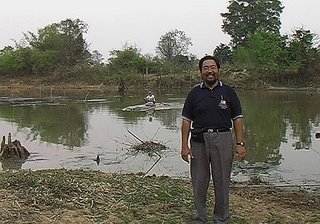Laos (Part 1)
After a domestic flight connection on Thai Airways from Bankok to Udon Thani we board a Korean built van and head toward the Thai border with Laos. At this point, the mighty Mekong river is an international boundary and appears impressive in spite of the current dry season. We cross the border without incident after filling out the Thai departure forms and Laotian arrival forms on the respective sides of the border and pay the entry fees. Having Mark P to lead us is a tremendous help as he knows all the entry procedures well and can speak Thai which is phonetically similar to the Lao language.
We drive from the border through the outskirts of Vientiane directly to Savannakhet in central Laos – a long journey that will take a further 8 hours. We were able to see a little of the somewhat impoverished interior as well as the rapid development of some urban centres and we finally arrive at around 11pm. Savannakhet seems like an outback town with no high rises buildings; the government administrative buildings being among the newest and most impressive. But even here in the rural towns one can easily find internet access for the equivalent of around RM3 an hour.
The MOU is finally signed in the afternoon of the second day after waiting most of the morning in a government building for the Laotian provincia
 l government officials to arrive only to have them ask for more time to study the translation of the document. It looks like the Wawasan GMR (Greater Mekong Region) will eventually have to get properly started on the proposed feasibility study (what the MOU was for) which I think is still in a state of gestation.
l government officials to arrive only to have them ask for more time to study the translation of the document. It looks like the Wawasan GMR (Greater Mekong Region) will eventually have to get properly started on the proposed feasibility study (what the MOU was for) which I think is still in a state of gestation. After the signing ceremony we travel more than 2 hours east from Savanna-khet in the direction of the Vietnamese border and would like to take a look at the proposed project area to see what the terrain and ground cover is like but there are no roads into the area.
After the signing ceremony we travel more than 2 hours east from Savanna-khet in the direction of the Vietnamese border and would like to take a look at the proposed project area to see what the terrain and ground cover is like but there are no roads into the area. The closest we can get is by using footpaths from a village near where the project area is supposed to be. We walk in a short way on desiccated grass in dry rice fields passing several clumps of Siam weed (Chromolaena odorata) only to find a broken water-gate beside a small reservoir (supplying the general area).
The closest we can get is by using footpaths from a village near where the project area is supposed to be. We walk in a short way on desiccated grass in dry rice fields passing several clumps of Siam weed (Chromolaena odorata) only to find a broken water-gate beside a small reservoir (supplying the general area). Most likely as a result of un-controlled discharge through the broken water-gate, the water level in the reservoir is very low.
Most likely as a result of un-controlled discharge through the broken water-gate, the water level in the reservoir is very low.A little
 down the path we observe that the inlet of an irrigation water-gate meant to channel water from the reservoir to adjacent fields is completely dry because of the low level of water.
down the path we observe that the inlet of an irrigation water-gate meant to channel water from the reservoir to adjacent fields is completely dry because of the low level of water. Life for people in the 5 local villages seems hard. It is not hard to notice that the people often look somewhat like Malays or Chinese.
Life for people in the 5 local villages seems hard. It is not hard to notice that the people often look somewhat like Malays or Chinese.On our return to Savannakhet, we have a light meal at an esplanade beside the Mekong river. As it is past 8:30pm and already dark, we can see the lights from the Thai town of Mukdahan on the opposite bank. The roasted beef, chicken patties and grilled squid are delicious as are the ice blended sapodilla (chiku) drinks that are like smoothies. I am surprised at the carefree abandon to which we are consuming street food and iced drinks in a rural Laotian town.
We are later told that Mukdahan is a much larger and better developed town and a new bridge connecting the two riverside towns is under construction and is expected to be ready some time in 2007.


